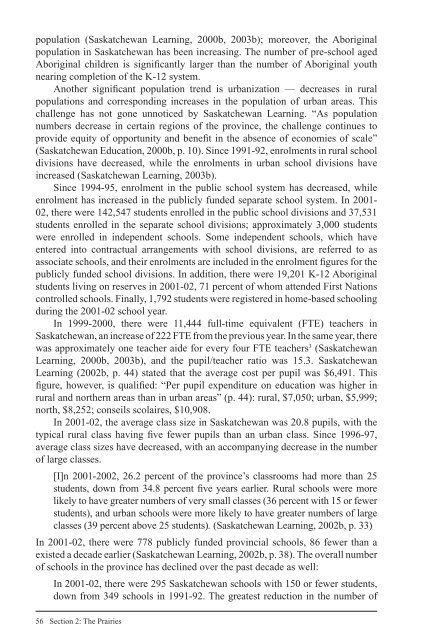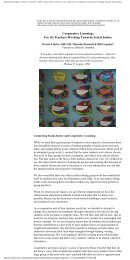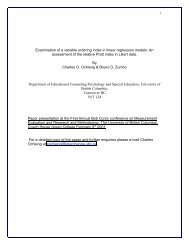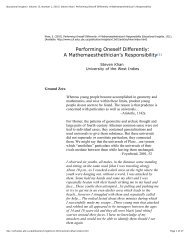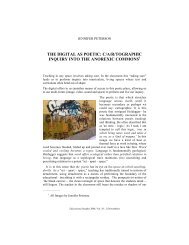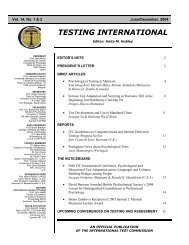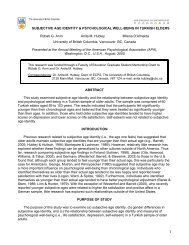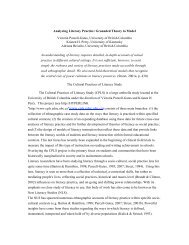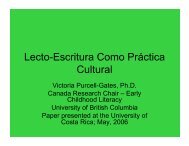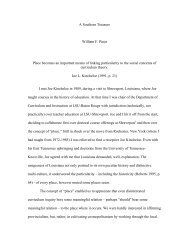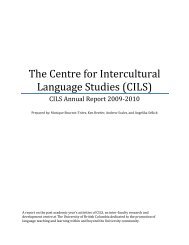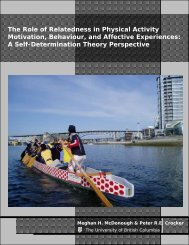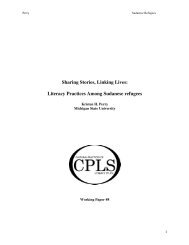The evolution of professionalism - Centre for Policy Studies in ...
The evolution of professionalism - Centre for Policy Studies in ...
The evolution of professionalism - Centre for Policy Studies in ...
Create successful ePaper yourself
Turn your PDF publications into a flip-book with our unique Google optimized e-Paper software.
population (Saskatchewan Learn<strong>in</strong>g, 2000b, 2003b); moreover, the Aborig<strong>in</strong>al<br />
population <strong>in</strong> Saskatchewan has been <strong>in</strong>creas<strong>in</strong>g. <strong>The</strong> number <strong>of</strong> pre-school aged<br />
Aborig<strong>in</strong>al children is signifi cantly larger than the number <strong>of</strong> Aborig<strong>in</strong>al youth<br />
near<strong>in</strong>g completion <strong>of</strong> the K-12 system.<br />
Another signifi cant population trend is urbanization — decreases <strong>in</strong> rural<br />
populations and correspond<strong>in</strong>g <strong>in</strong>creases <strong>in</strong> the population <strong>of</strong> urban areas. This<br />
challenge has not gone unnoticed by Saskatchewan Learn<strong>in</strong>g. “As population<br />
numbers decrease <strong>in</strong> certa<strong>in</strong> regions <strong>of</strong> the prov<strong>in</strong>ce, the challenge cont<strong>in</strong>ues to<br />
provide equity <strong>of</strong> opportunity and benefi t <strong>in</strong> the absence <strong>of</strong> economies <strong>of</strong> scale”<br />
(Saskatchewan Education, 2000b, p. 10). S<strong>in</strong>ce 1991-92, enrolments <strong>in</strong> rural school<br />
divisions have decreased, while the enrolments <strong>in</strong> urban school divisions have<br />
<strong>in</strong>creased (Saskatchewan Learn<strong>in</strong>g, 2003b).<br />
S<strong>in</strong>ce 1994-95, enrolment <strong>in</strong> the public school system has decreased, while<br />
enrolment has <strong>in</strong>creased <strong>in</strong> the publicly funded separate school system. In 2001-<br />
02, there were 142,547 students enrolled <strong>in</strong> the public school divisions and 37,531<br />
students enrolled <strong>in</strong> the separate school divisions; approximately 3,000 students<br />
were enrolled <strong>in</strong> <strong>in</strong>dependent schools. Some <strong>in</strong>dependent schools, which have<br />
entered <strong>in</strong>to contractual arrangements with school divisions, are referred to as<br />
associate schools, and their enrolments are <strong>in</strong>cluded <strong>in</strong> the enrolment fi gures <strong>for</strong> the<br />
publicly funded school divisions. In addition, there were 19,201 K-12 Aborig<strong>in</strong>al<br />
students liv<strong>in</strong>g on reserves <strong>in</strong> 2001-02, 71 percent <strong>of</strong> whom attended First Nations<br />
controlled schools. F<strong>in</strong>ally, 1,792 students were registered <strong>in</strong> home-based school<strong>in</strong>g<br />
dur<strong>in</strong>g the 2001-02 school year.<br />
In 1999-2000, there were 11,444 full-time equivalent (FTE) teachers <strong>in</strong><br />
Saskatchewan, an <strong>in</strong>crease <strong>of</strong> 222 FTE from the previous year. In the same year, there<br />
was approximately one teacher aide <strong>for</strong> every four FTE teachers3 (Saskatchewan<br />
Learn<strong>in</strong>g, 2000b, 2003b), and the pupil/teacher ratio was 15.3. Saskatchewan<br />
Learn<strong>in</strong>g (2002b, p. 44) stated that the average cost per pupil was $6,491. This<br />
fi gure, however, is qualifi ed: “Per pupil expenditure on education was higher <strong>in</strong><br />
rural and northern areas than <strong>in</strong> urban areas” (p. 44): rural, $7,050; urban, $5,999;<br />
north, $8,252; conseils scolaires, $10,908.<br />
In 2001-02, the average class size <strong>in</strong> Saskatchewan was 20.8 pupils, with the<br />
typical rural class hav<strong>in</strong>g fi ve fewer pupils than an urban class. S<strong>in</strong>ce 1996-97,<br />
average class sizes have decreased, with an accompany<strong>in</strong>g decrease <strong>in</strong> the number<br />
<strong>of</strong> large classes.<br />
[I]n 2001-2002, 26.2 percent <strong>of</strong> the prov<strong>in</strong>ce’s classrooms had more than 25<br />
students, down from 34.8 percent fi ve years earlier. Rural schools were more<br />
likely to have greater numbers <strong>of</strong> very small classes (36 percent with 15 or fewer<br />
students), and urban schools were more likely to have greater numbers <strong>of</strong> large<br />
classes (39 percent above 25 students). (Saskatchewan Learn<strong>in</strong>g, 2002b, p. 33)<br />
In 2001-02, there were 778 publicly funded prov<strong>in</strong>cial schools, 86 fewer than a<br />
existed a decade earlier (Saskatchewan Learn<strong>in</strong>g, 2002b, p. 38). <strong>The</strong> overall number<br />
<strong>of</strong> schools <strong>in</strong> the prov<strong>in</strong>ce has decl<strong>in</strong>ed over the past decade as well:<br />
In 2001-02, there were 295 Saskatchewan schools with 150 or fewer students,<br />
down from 349 schools <strong>in</strong> 1991-92. <strong>The</strong> greatest reduction <strong>in</strong> the number <strong>of</strong><br />
56 Section 2: <strong>The</strong> Prairies


